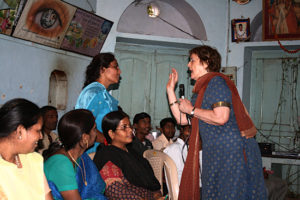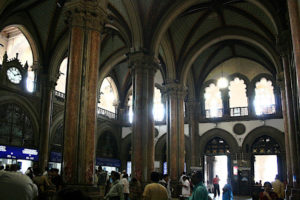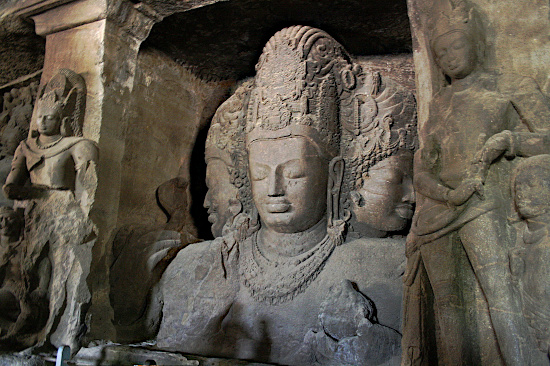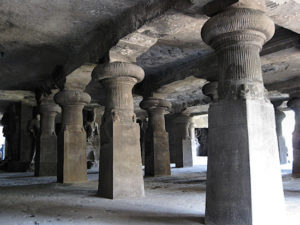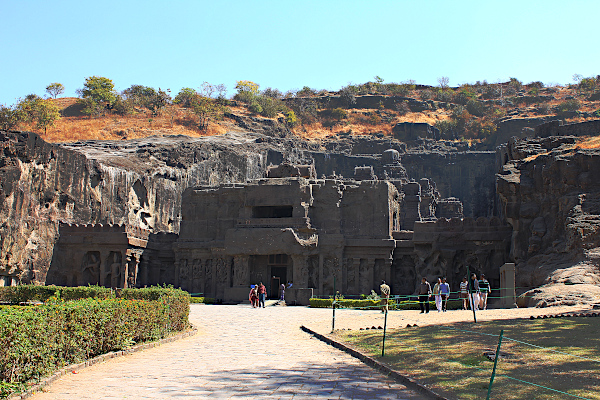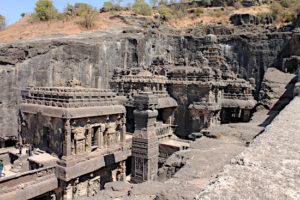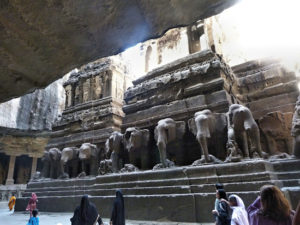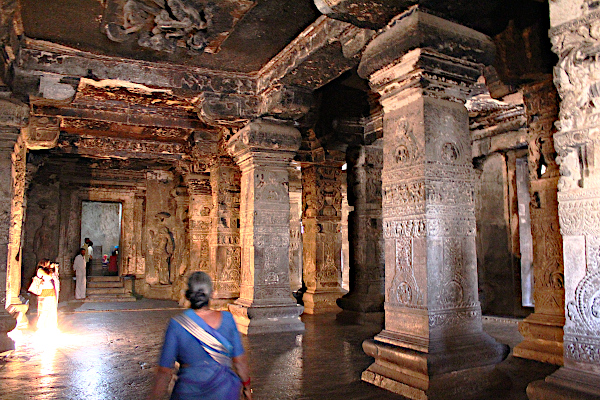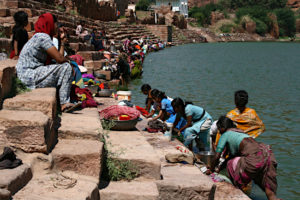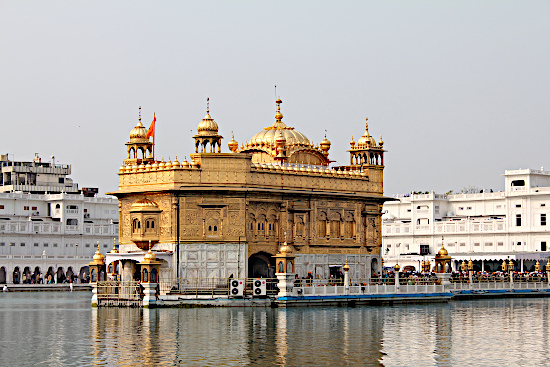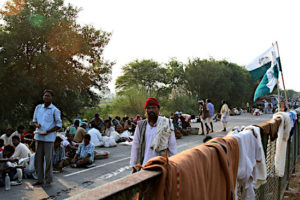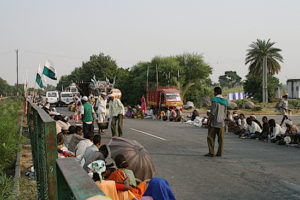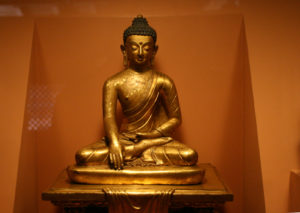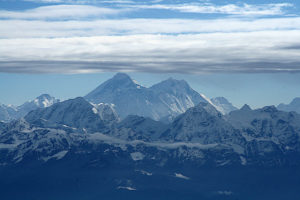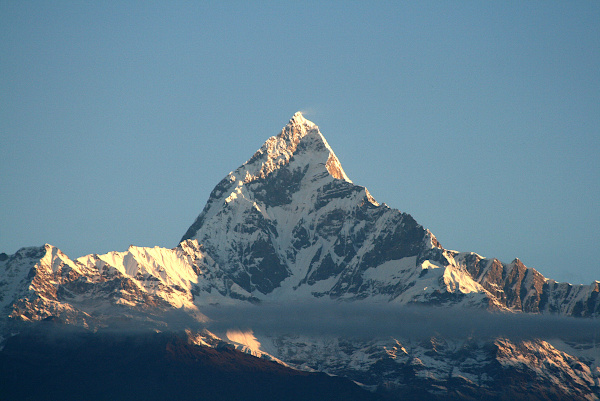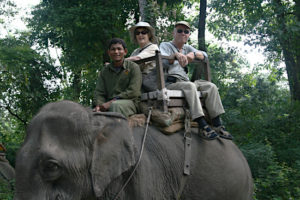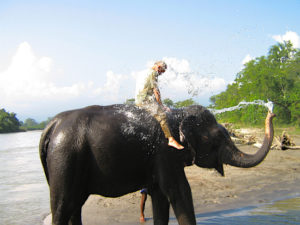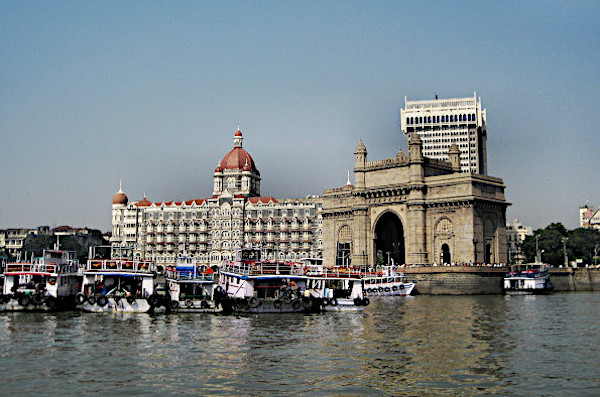
The waterfront of Mumbai seen from the boat to Elephanta Island with the Gateway of India and, left, the Taj Palace Hotel,
Mumbai (Maharashtra) and Karnataka
We arrived in Mumbai (formerly Bombay) from Varanasi in October, 2009. I had, once again, been teaching “English without books” in Varanasi to the DEVA staff, using a method which I had begun the previous year, gestures and actions accompanying my speaking instead of the written word.
It had been a lot of fun again, and I had been wearing my first salwar kameez (made in Tanjore, Tamil Nadu, in 2008). I had, however, been very careless with the shawl that was hanging far too low in the front. (It got worse later on during the class, from all my gesticulating.) Indian women are forever adjusting their shawls, but I had obviously not sufficiently learned about that important detail.
We very much wanted to get to know Mumbai, since it is a spectacular city and also the home of Salman Rushdie, who is one of our favorite writers. He lived on Malabar Hill as a young boy and he refers to it at least in “Midnight’s Children”. So, on our first evening in Mumbai we took a cab from our hotel, along the west shore bay called “Back Bay”, to Malabar Hill where we got to see the up-scale high-rise buildings, the kind Rushdie most certainly grew up in. He came from a very well-to-do English speaking family.
We went back to Malabar Hill on our tour of Mumbai with a very good woman guide, and we looked around the entire area some more then. That was when we saw the proximity of the poor people’s shacks on the edges of the the Banganga Tank, where dhobis washed laundry for the well-to-do people. There were also more shacks out on the side towards the sea, the west coast now – Mumbai is situated on a peninsula.
The contrasts between the rich people’s high-rise buildings on Malabar Hill and the shacks below is stark, but unfortunately there are far too many places in India where you get to see similar contrasts. The drive from Varanasi Airport into the city has now become somewhat similar, since a number of up-scale, high-rise buildings have grown up next to the poor people’s low and downtrodden houses. One day the lower-class houses will probably have given way to more luxury buildings.
We had actually seen a small city of Dalit slum dwellings against a background of wealthy looking high-rise buildings on our way into the city from the airport. Obscene contrasts are everywhere in India.
We visited with our woman guide the Chhatrapati Shivaji Terminus, the former Victoria Terminus, possibly the most grandiose railroad station in the world — interior and exterior built in some quasi-Gothic style. It was definitely worth a visit.
We saw the Elphinstone College, another impressive colonial building, quasi-gothic as well, where the rich young Indians most likely got a perfect English education. That may have changed some though after 1947. And our guide took us to the hilariously impressive Mumbai open-air laundry business, the Mahalaxmi Dhobi Ghat. I bet that laundromat has no rivals in the world.
Elephanta Island,
In all, we spent a few interesting days in Mumbai — the last day on a boat tour to Elephanta Island with its Elephanta Caves, a UNESCO World Heritage Site. The caves were carved out of the rock and the numerous relief sculptures inside the caves are quite impressive. The caves with their statues date back to the 2nd century BC. It is hard to believe that all these caves and relief statues were really carved out of the rock — over 2000 years ago.
Ellora caves — Kailasa Temple
We got to see something a bit similar, but even more mind-blowing, in 2012. It was the Ellora caves in the state of Maharasthra. We were particularly impressed by Kailasa Temple, which was hewn out of the rock in the 8th century CE. It should have been the eighth wonder of the world, but alas they were hundreds of years too late for the ancient Greeks to consider them.
From Mumbai we went by plane to Bangalore (Karnataka), our starting point where we got a driver to take us to Hampi and Badami, on the worst roads we have ever encountered in India. And that is saying a lot.
In 2009 we were in Bangalore where our Facebook friend Amina lived at the time with her “petite famille“, as the French say. — husband and a young son. We spent a very pleasant evening with them and got to see the Indira Gandhi Musical Fountain Park, with elaborate fountains and light effects.
I also met with Amina’s bearded brother the following morning who wanted to talk to me about my political writings. He suggested contacting a publisher in Calcutta who might be interested in publishing some of my essays. That was a dead end though, since the man in question was an arch-conservative and didn’t at all go for my putting down of the United States as the villain of this era and its endless wars of destruction, first of all of the Middle East.
Hampi
The ancient city in this region was Vijayanagara which was the capital of the Vijayanagara Empire that dated from 1336. It lasted for 200 years and, in the medieval era, Vijayanagara was the second largest city in the world, after Beijing. In 1565, a coalition of neighboring Muslim kingdoms defeated the armies of the empire, which was mostly Hindu. ”Its capital was conquered, pillaged and destroyed by sultanate armies in 1565, after which Hampi remained in ruins.” (Wikipedia).
We spent a few exciting days in Hampi, making trips all around the town of Hampi to look at all the various temples and mandapas left from the Vijayanagara Empire era. We loved the huge rocks with the ruins of small temples and shrines that looked as if they had grown out of the rocks. I especially adored Hemakuta Hill, the enormous flat rock right next to the town.
Vijayanagara traded with regions as far away as Persia and the Portuguese colony of Goa. You can still see today what was once the center of trade, a street still lined with the pillars to house the bazaars, and the Virupaksha Temple towering at one end of the street.1 For more pictures of Hampi and surroundings click here.
Badami
From fascinating Hampi we went on to Badami to the north. More bad roads. Well, that’s India for you. These were roads that were more potholes than anything else, so it was slow and tiring traveling. We saw quite a few carts pulled by buffaloes on the road; they were richly decorated and we guessed there was some festivity somewhere along this sad road. There was even a decorated three-wheel truck of sorts with young people standing up on the roof in the Indian style. You even see buses anywhere in India that seem to have more passengers outside than inside the bus.
The hardship, mostly for the driver, I admit, was well worth it though. The next day we climbed up several flights of stairs to get to some highly decorated caves, different from any we had seen before or would be seeing later. Also, there was a variety of religions represented in these caves, mostly Hindu but also Buddhist and Jain. The rocks themselves were gorgeous and multi-colored, ranging from orangey red to black to almost white. I had been a bit out of it for a couple of days, and our driver, Pradeepa, always a gentleman, as
John says in our tripbook-album, was adorable lending me a supporting hand as we walked up the unending steps.
In Hampi the town was not very interesting, but Badami was full of life. There were the markets and, above all, the very picturesque sight of the women washing their laundry. No dhobis here – it seems as if every woman is her own dhobi woman and she carries her laundry back and forth on her head.
We spent one day in Ambedkar, to visit the Golden Temple and even to drive over to the Pakistani border close by to watch the change of the Guard. The Golden Temple was quite an amazing sight, but the change of the guard was a silly spectacle with a lot of hullabaloo on both sides. There was an enormous crowd and everyone seemed to cheer. The goosestepping was the most ridiculous show of that kind I have ever seen.
Dharamsala
Dharamsala is the headquarters of Kangra district; in British times it was part of the province of Punjab on the border of Pakistan. It is now widely known as the site of the Dalai Lama, who has his temple and abode in McLeod Ganj, a town situated on the northern hillside above Dharamsala, sometimes referred to as a suburb of Dharamsala.
We decided in 2012 that we would like to see the Dalai Lama’s temple and the place where he had settled after escaping from his palace in Lhasa in March 1959.2
It was February and we had prepared ourselves for cold weather, lightweight padded jackets and some more warm things, but we had not expected the snow we got on our first evening.
Our driver from Amritsar, though, had prepared for nothing and he did get a bad cold. Someone lent him a blanket and he walked around wrapped in it for this few days’ stay. We went to see how he was doing every day and he kept in good spirits, even though all the drivers slept in a shack that may not even have been heated.
On our first evening we were told that the Buddhist monks were going to have a huge candle procession, passing through the town. We walked down from our high-level hotel and we saw these men, some with naked arms under their deep-red robes, woolen at least. But, actually, quite a few of them were wearing woolen sweaters under their robes. They claim though that they can discipline themselves not to feel cold. It is faith that keeps them from freezing. Oh well…
A mass of deep-red robes, the burning candles in cold hands, snow flakes falling in the waning evening light. I will never forget that impressive sight. The next morning everything was covered in snow.
During the couple of days we spent in McLeod Ganj, we went to a neighboring picturesque little town from where we went on a pleasant little hike to a narrow waterfall that fell over cliffs into a pretty valley. After a quick lunch on the worst sandwich I think I have ever tasted, we went to visit the “Tibetan Children’s Village” back to McLeod Ganj. The children who often first of all have to be taught the Tibetan language, were given a good education here, and a home. Health services were of course available, hospital and all.
Since most of the refugee children had lived with Chinese families where they had been forced to live by the authorities, taken away from their parents, they did not even speak their own language. The Chinese politics in Tibet are not pretty.
It was now winter vacation and only some very young children were in the village at this time. We had long talks with the women who ran this Tibetan “village”, and they of course wanted us to sponsor a child from their village. We said at our hotel that seemed closely connected to this village that we already had two foster children in India. They said “So then you will have three.” But that did not get to be.
The following afternoon, the Dalai Lama was receiving the Archbishop Desmond Tutu, the iconic South African fighter against apartheid and general human rights activist who received the Nobel peace prize in 1984. This was a complete surprise for us.We had just lucked out again. We had been advised by the woman who managed the village to get to the temple early, to get seated at all.
We got there early but not early enough, and we did not get seated. As I came in alone, I caught sight of this woman and it was so very funny. We must really have made friends, and when I caught sight of her, she turned around and said “Where is John?”, just as if we had been at home in Genas.
What had happened was that John and I arrived happily at the temple, our cameras hanging around our necks. We were immediately told that cameras were on that day strengstens verboten. John had to go down and then up and up to our hotel to get the cameras back safely in our room. From where I was standing in the back I waved and waved to my husband when he got back. He saw me and all was well. We had good standing room places anyway and later on, when people started moving some, I actually got a seat. The surface of the temple had been at least doubled by adding a large area under huge yellow tarpaulins.
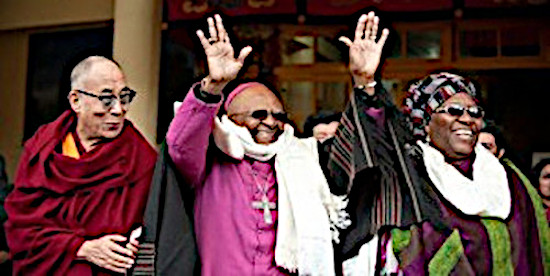
The Dalai Lama receiving Archbishop Desmond Tutu and his wife, Nomalizo Leah Shenxane, in McLeod Ganj on March 10 2012.
We were waiting for well over an hour for the two great men to appear They were finally announced by music an dancers on the side where they entered, across from where we were standing.
We suspected that something had gone wrong with Desmond Tutu’s transportation. Once they were seated in front of the temple, the real dancing got started and the Tibetan hoopla went on for a very good while.
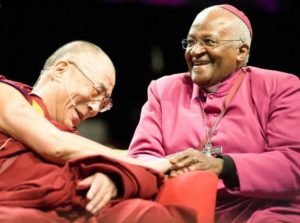
The Dalai Lama and the Archbisho Desmond Tutu, always ready for a good laugh
Then finally the two celebrities began to talk. They even joked a great deal and they laughed a lot. Desmond Tutu joked about the Dalai Lama not being able to speak proper English and still making full-room appearances all over the world.
This was a historic event we had no idea we were going to attend. It is amazing how often similar unexpected and important events have occurred during our travels, but this one was probably the most memorable one.
Janadesh
Another surprising and important event that we were lucky enough to witness was on the way from Delhi to Agra by car. This was in October 2007 and we were on our way to Agra to see the Taj Mahal. We were suddenly stopped where one side of the expressway had been shut down for a farmers’ gigantic march. At the time we had no idea of how very important this event was.
Farmers, or more often landless people and their wives, were walking from Gwalior to Delhi in an enormously well- organized campaign to be heard by the government concerning land reforms. The majority of the marchers were landless Adivasi — tribal people — and Dalits. This campaign, which had been going on since 2005, was called Janadesh which ” means “The Verdict of the People” in Hindi. This march was, however, the climax that the movement had been planning for.
The entire march, 350 km long was a thing that could only happen in India, I believe. The 25,000 people who were involved in the march actually lived on the road for the weeks it took them to cover the 350 kilometers to Delhi. They had their meals and did their washing and whatever else is included in the word “living” on the road during the weeks it took the marchers to get to Delhi.
The organizers of the march did get to see the Prime Minister (if I am not mistaken), and I do hope that this gigantic march and its immensely important message had some positive outcome. The entire scene was quite overpowering. Janadesh supplied big white trucks which clearly supplied food and water and, most certainly, medical assistance if needed.
Wikipedia says: “According to Ekta Parishad (movement for landless and homeless people and organizers of Janadesh) the lack of secure land rights is major contributor to rural poverty in India, and the government of India needs to undertake major land reforms to address this issue. The aim of the Janadesh campaign is to put pressure on the Indian government to undertake specific land reforms aimed at securing land rights for the poorest groups in India.”
Nepal and the Himalayas
We had wanted to go to Nepal already, but were worried by the political situation. It cleared up in 2007, so we went in 2008. It cleared up in 2007, so we went in 2008.We arrived in Varanasi only after we had gotten fierce colds at the Chitwan National Park, which we otherwise enjoyed very much. It was different from anything we had previously seen and experienced.
We started out in Kathmandu and nearby Patan with its most astounding museum and its Golden Temple. Then we went on to Bhaktapur, where there were of course yet more pagodas.The masses of pagodas in the squares (often called Durbar Square) with their grace and beauty were amazing. We commonly associate this temple style with China, but actually it originated from Nepal and then moved east.
From Kathmandu we took a little plane with the company Buddha Airline. It took fewer than 15 passengers and it let us see the snowy fairyland of the Himalayas and Mount Everest from above. It was quite impressive even that way. I remember thinking it was not as snow-covered as I had expected, but in our picture it looks quite snowy.
After traveling east to visit Dhulikhel, we made a well planned trip to Pokhara in the Northwest to see the sun rising over the Himalayas. In that enormous chain of high mountains, it was the Annapurna range we were seeing. Fabulous. We were at the top of a small mountain at a place called Sarangot just north of Pokhara and we were not alone.
The Himalayas didn’t let us down. The Annapurna range was magnificent and as the sun rose over the snow-covered mountains it was magic.
We spent three nights in Pokhara. As we left, we were impressed by the beauty of the Annapurna Range looming over the town.
We now had just one more place to visit in Nepal, but what a place! It was Chitwan National Park in the very south of Nepal. Among other things we were expecting to see some rhinoceroses, which are rare everywhere in the 21st century. However, on the road going south there was a very serious back-up or actually a stand-still of traffic. It lasted for several hours and its cause was the complete shutting down of the road by the people in a village to protest the killing of one of their young villagers by a bus driving too fast through the town. One result was we were late arriving in Chitwan.
The fact was that we completely missed the elephant ride to look for rhinoceroses. All we ever saw were their gigantic foot prints. We were of course given a funny and interesting elephant ride anyway, and to make up for the missed rhinoceros sighting, we were offered a beautiful ride up the river bordering the national park, and it was a most pleasant trip up the calm and shallow river. The boat was punted, not rowed and the young men were extremely skillful at punting.
The camp is a beautiful collection of small individual houses, raised up on posts, clearly for the monsoon season. The reception (accueil — the perfect word) was wonderful and there was an evening entertainment of excellent village dancers.
The next day there was general bathing in the river, even though no one seemed to have any bathing suits. People got in the water in shorts and T-shirts and John was wearing pants and a shirt. I considered getting in but decided that this was not for an old lady like me — yes, even in 2008. The major bathers however, were the elephants, who, as we knew already from Jaipur in 2006, love getting into water.
John was helped up on an elephant and I was ready with my camera. The most fun picture of John’s adventure where he got thoroughly dipped in the water by the elephant, was the final one where he is completely showered by the beast.
We somehow managed after our short stay in the jungle, to get a flight from close by to Varanasi. We arrived in Varanasi with bad colds, both of us, even the one who had not been in the water at Chitwan National Park.
Thoughts about India
The travels I have talked about here and Varanasi in the First part of Chapter 40 are just a selection of all our travels in India over eight years 2006-2014. All those long visits made us witness and, to an extent, experience a totally different world and way of life. It was fascinating but also frightening to see, for example, the treatment of the Dalits, and the extreme poverty visible in shantytowns all over India, especially on the outskirts of the big cities. Some states, such as Uttar Pradesh, suffer more from poverty and its consequences, malnutrition and the very sad cases of mentally and physically handicapped children — usually a result of the mother’s malnutrition during pregnancy and breastfeeding.
Books have been written about travels in India alone, with views of the immensely varying living conditions, from obscene luxury almost next-door to desperate poverty, such as just don’t see in the West. That is what our dear French friend, Jean-Max calls la misère. DEVA, the organization we are closely connected to in Varanasi, Uttar Pradesh, would not exist today if it had not been for dear Jean-Max who organizes the finances of DEVA, mostly from France.
The entirely sunny side of DEVA for us is, however, our foster-daughter, Sampa, who is now doing her fourth and finishing year, brilliantly, at an institute for design in Hyderabad. She has always been a very talented artist and we are confident that this four-year education will suit her perfectly. I hope she will then be able to move her mother, our dear friend Vimla, into a more comfortable apartment where there is running water and a real kitchen. They now live in an old former maharaja’s palace which has been restored to house a lot of small apartments.
Continued: Chapter 41 — Exotic countries
- In 1520, Domingo Paes, a Portuguese traveler, visited Vijayanagara as a part of trade contingent from Portuguese Goa. He wrote his memoir as Chronica dos reis de Bisnaga, in which he stated Vijayanagara was “as large as Rome, and very beautiful to the sight … the best provided city in the world”. According to Paes, “there are many groves within it, in the gardens of the houses, many conduits of water which flow into the midst of it, and in places there are lakes.” (Wikipedia. ↩
- “How and Why the Dalai Lama Left Tibet”> — After years of guerrilla war between Tibetan rebels and the Chinese soldiers in a land that China considered to be its territory, the friendly overture seemed suspicious enough that, on the day of the performance, thousands of protesters surrounded the Dalai Lama’s palace in Lhasa to keep him from being abducted, arrested or killed. Over the following few days, the protests expanded into declarations of Tibetan independence and the mobilizing of rebel troops to fight the Chinese forces. The State Oracle, the Dalai Lama’s advisor, urged him to flee.
On this day, March 17, in 1959, Tibet’s spiritual and political leader, then 23, disguised himself as a soldier and slipped through the crowds outside the palace he’d never see again. He embarked on a dangerous journey to asylum, crossing the Himalayas on foot with a retinue of soldiers and cabinet members. They traveled only at night, to avoid detection by Chinese sentries. Rumors later circulated among Tibetans that the Dalai Lama “had been screened from Red planes by mist and low clouds conjured up by the prayers of Buddhist holy men,” according to TIME’s 1959 cover story about the escape. But until he appeared in India, two weeks after taking flight, people around the world feared that he had been killed, according to the BBC. <a href=”https://time.com/3742242/dalai-lama-1959/”>TIME</a> ↩


